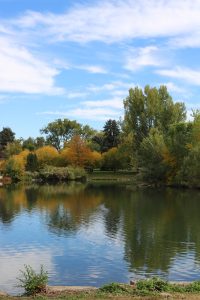
Nestled in Birmingham’s historic West End community, **Harrison Park** at 901 17th St SW stands as a testament to the city’s commitment to green spaces and community enrichment. Spanning 6.55 acres in the Oakwood Place neighborhood, this park has served generations of residents since its establishment in the early 1920s under the guidance of parks commissioner William L. Harrison, after whom it is named. Developed on land acquired from local families for $16,390, the park’s layout reflects both practicality and vision, offering a blend of recreational facilities and natural beauty. Its boundaries, framed by Bethel Baptist Church, Pearson Avenue, and Norfolk Southern Railroad tracks, position it as a cornerstone of the neighborhood, providing a serene escape amid urban surroundings.
The park’s evolution mirrors Birmingham’s broader efforts to expand public amenities. In 1925, the Olmsted Brothers’ landmark report *A Park System for Birmingham* highlighted the city’s urgent need for parks, noting that its 600 acres of green space were “wholly inadequate” for a population of 200,000. Harrison Park emerged as part of this push, with its original community center—a modest frame structure built in 1926—funded in part by the West End Music Study Club. This early collaboration between civic groups and the city laid the groundwork for future developments, including the Works Progress Administration (WPA)-constructed recreation center completed in 1936. Designed to host activities ranging from folk dancing to theatrical productions, the red-brick facility featured a gymnasium doubling as a 600-seat auditorium, meeting rooms, and a kitchen, solidifying the park’s role as a cultural hub.
Today, Harrison Park balances historical charm with modern functionality. Visitors can explore a gazebo, walking paths, and a playground on the northern end, while the southern section boasts four lighted tennis courts and the enduring WPA recreation center. Though the original basketball court has been retired, the park’s layout—divided by a concrete swale leading to Nabors Branch—creates distinct zones for relaxation and activity. The Olmsted Brothers’ vision of accessible green spaces remains evident here, with the park serving as a “beauty spot” that fosters community connection. Annual events, such as home demonstration shows hosted by the West End Civitan Club in the mid-20th century, exemplified its role in civic life, a tradition that continues through contemporary programming.
As a city park, Harrison Park exemplifies Birmingham’s dedication to preserving history while adapting to residents’ needs. Its story—from the grassroots fundraising efforts of the 1920s to its WPA-era upgrades—highlights the collaborative spirit that defines the city’s approach to public spaces. For visitors, the park offers more than recreation; it provides a tangible link to Birmingham’s past, from the Olmsted-inspired planning era to the community-driven initiatives that keep its legacy alive. Whether through a quiet stroll along its tree-lined paths or participation in a local event, Harrison Park remains a vital thread in the fabric of West End, embodying the enduring value of shared green spaces in urban life.
Located at 901 17th St SW, Birmingham, AL 35211, Harrison Park continues to welcome residents and visitors alike, offering a blend of history, recreation, and community spirit. Its enduring presence underscores the importance of accessible public spaces in fostering connection, wellness, and civic pride—a mission as relevant today as it was a century ago.
Copyright @ Harrison Park. All rights reserved.
This is not the official website. Content is updated by the community.
If you are the owner, please contact us to verify or suggest edit this content.
Copyright © LocalParks | All rights reserved. Address: 1950 Adams Drive, Damon, TX 77430, United States.